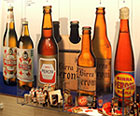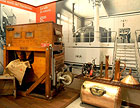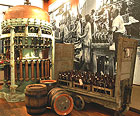Section 1
Section 2
Section 3
Section 4
G.P.:. It’s interesting that the idea of creating a museum came before the one of the archives. Usually it’s the other way around.
D.B.: We found objects from the 60s put aside with a nota “Museum” attached. In the company, we referred to “the museum” as a forgotten place inside the storehouse of the Roman plant. In fact, we found a lot of wonderful things there, including Peroni’s oldest illuminated sign, dating back to the end of the 19th century: treasures that we had forgotten about. Fortunately, someone had started keeping these items about over 50 years ago.
 Maybe this only happens in a family business, I’m not sure, but it certainly happened at Peroni, where the project of the Archives and the Museum had been hatching for a long time.
Maybe this only happens in a family business, I’m not sure, but it certainly happened at Peroni, where the project of the Archives and the Museum had been hatching for a long time.
G.P.: Have you found something on the history of this first idea? I was struck by something you said before: both the entrepreneur and a second branch of the family were strongly in favor of the project.
D.B.: Yes, all parts of the Peroni family working inside the company, as well as other historic shareholders were convinced of the quality of the project.
G.P.: Historic shareholders?
D.B.: At the beginning of the 20th century, there was an important merger between Peroni and the Ice and Artificial Snow-Making Company of Rome. Other important families of entrepreneurs came from that company.
Between 2003 and 2005, the Peroni Company’s ownership radically changed. Today, the South African multinational SABMiller owns the entire block of shares. However I want to point out for the sake of historical precision, that the Archives and the Museum project grew out of the previous ownership.
G.P.: So, the project was supervised directly by the Chairmanship.
 D.B.: Yes, with all the pros and cons of the situation: on one hand, this ensured that all the projects proceeded quickly, however, there is the risk of binding the structures to a single internal sponsor and therefore, not ensuring them autonomous continuity with the passing of time. From the start, enlightened entrepreneurs need to think about how their project will continue its legacy.
D.B.: Yes, with all the pros and cons of the situation: on one hand, this ensured that all the projects proceeded quickly, however, there is the risk of binding the structures to a single internal sponsor and therefore, not ensuring them autonomous continuity with the passing of time. From the start, enlightened entrepreneurs need to think about how their project will continue its legacy.
G.P.: So how did it follow through? How did the museum work from an organizational point of view? Was it delegated to a department within the company?
D.B.: Yes, it was. Since 2002 the Archives and the Museum have been part of the External Relations Office, which gave the structure greater autonomy and positioned it at the heart of company life. A project that is sponsored from the top might find a lot of open doors but it tends to stay on the fringe of real life.
 For a short time we examined the possibility of creating an nonprofit foundation, but it was too complicated at the organizational, bureaucratic and property levels. So we gave up that idea. Today there are cases that are perhaps more stable because the cultural investment is independent from company’s fluctuations. However, the price to pay is often detachment from real company life. Both solutions have their limits. Surely the Peroni Archives and Museum have the advantage, especially after the change of ownership in recent years, of being perceived as the place to record and display what is useful for the company, and to represent Peroni in its current industrial and commercial situation. To this end, one of our first priorities is the recording of last year’s advertising and promotional material.
For a short time we examined the possibility of creating an nonprofit foundation, but it was too complicated at the organizational, bureaucratic and property levels. So we gave up that idea. Today there are cases that are perhaps more stable because the cultural investment is independent from company’s fluctuations. However, the price to pay is often detachment from real company life. Both solutions have their limits. Surely the Peroni Archives and Museum have the advantage, especially after the change of ownership in recent years, of being perceived as the place to record and display what is useful for the company, and to represent Peroni in its current industrial and commercial situation. To this end, one of our first priorities is the recording of last year’s advertising and promotional material.
It is the finicky archivist’s duty to make the business aware of the importance of keeping the paper documents that go with the objects connected to a product: at the moment, a new lot of documents is being recorded and is about to receive the notification of historical interest: a business archive’s main purpose is to increase with new streams of documents.
It is very difficult to mediate between archival theory on the correct management of an archives and the company’s practical needs for space.

Surely, the soul of an enhancement project like the Peroni’s is the entrepreneur’s devotion, even if Dr. Natali spoke very little about himself in relation to the Museum. The initial framework for the museum exposition was very clever, and so was the outline for the reconstruction of the company’s history in its celebration volume. It focussed less on the family, and more on the company, its products and people as an integral part of our Italy’s social, economic and cultural history. In my opinion,
this fomulation works well with the new owners who, I must say, are sensitive to Peroni’s traditions, even though they have set minimum maintenance of the two structures as a target. Actually, that’s not so bad these days!
The use of illustrations kindly granted by Archivio storico Peroni
